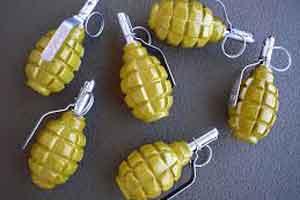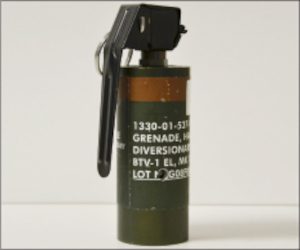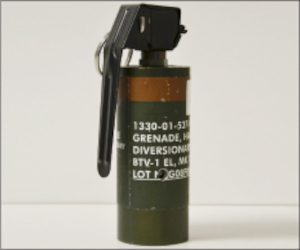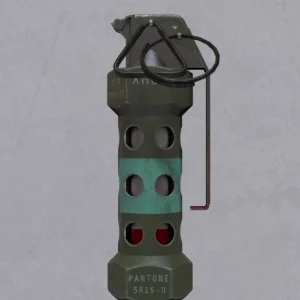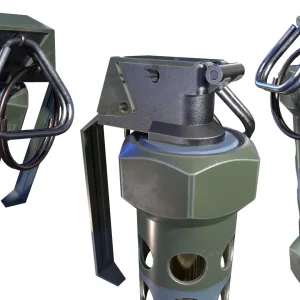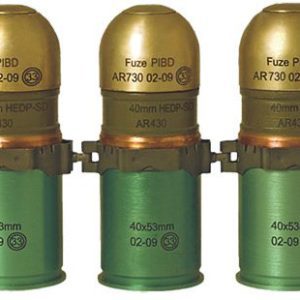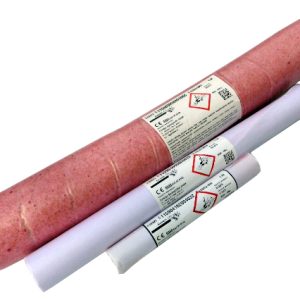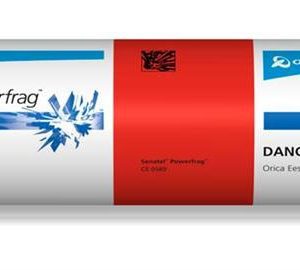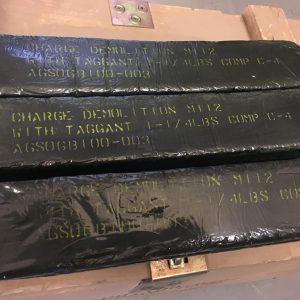An explosive is a reactive substance that contains a great amount of potential energy that can produce an explosion if released suddenly, usually accompanied by the production of light, heat, sound, and pressure. An explosive charge is a measured quantity of explosive material, which may either be composed solely of one ingredient or be a mixture containing at least two substances. The potential energy stored in an explosive material may, for example, be • chemical energy, such as nitroglycerin or grain dust • pressurized gas, such as a gas cylinder, aerosol can, or BLEVE • nuclear energy, such as in the fissile isotopes uranium-235 and plutonium-239. Explosive materials may be categorized by the speed at which they expand. Materials that detonate are said to be “high explosives” and materials that deflagrate are said to be “low explosives”. Explosives may also be categorized by their sensitivity.
This category contains explosive devices, chemical agents, and similar matters; for mixtures and types of explosives.
Explosive
An explosive is a reactive substance that contains a great amount of potential energy that can produce an explosion if released suddenly, usually accompanied by the production of light, heat, sound, and pressure. An explosive charge is a measured quantity of explosive material, which may either be composed solely of one ingredient or be a mixture containing at least two substances. The potential energy stored in an explosive material may, for example, be • chemical energy, such as nitroglycerin or grain dust • pressurized gas, such as a gas cylinder, aerosol can, or BLEVE • nuclear energy, such as in the fissile isotopes uranium-235 and plutonium-239. Explosive materials may be categorized by the speed at which they expand. Materials that detonate are said to be “high explosives” and materials that deflagrate are said to be “low explosives”. Explosives may also be categorized by their sensitivity.
Low Explosive
An explosive which utilizes chemical formulas which combust when a certain amount of initial energy is applied to them. Fireworks fall into this category. The rate at which the pyrotechnic composition burns is mostly dependent upon the rate at which the composition can transfer heat from one layer of itself to another. When a composition’s rate of reaction is very slow (relative to the speed of sound), it is known as deflagration. Examples of a pyrotechnic composition which “deflagrate” would be a star in an aerial shell, flares, or black powder. Burn rate is also highly dependent on pressure and temperature. Therefore, when a pyrotechnic composition is confined, its burn rate is accelerated. When the reaction is sped up drastically due to increases in pressure and temperature, such as the case with the burst charge in an aerial shell, it becomes explosive, but is still subsonic and is still deflagration. In an aerial shell, the temperature and pressure build up while the composition inside of it is burning. Once the pressure from the hot gases created during the reaction reaches a certain point, the casing will fail, rupturing outward, giving an explosion.
High Explosive
A device in which the explosive composition will detonate once initiated. High explosives can be initiated in several manners. The typical method in which high explosives are initiated is through a blasting cap, which sends a shock wave into the material. The other method of initiation is deflagration to detonation. An example of this process is seen in composition that has great ability to transfer heat and it’s high heat of reaction (thermal energy produced when it combusts). Since the rate at which a composition burns is dependent upon how well it can transfer heat, this is a very important property. Once ignited, if the flame front in a composition reaches supersonic velocities it creates a shock wave in the composition. Once a shock front is accomplished, the rate at which the composition burns is no longer dependent on how well it can transfer heat (as in the case of a low explosive). The burn rate is now dependent upon how well the explosive composition can transfer the detonation wave (shock wave) through itself. Most blasting caps are created using a composition that undergoes a deflagration to detonation process to allow a simple spark to eventually lead to the shock wave needed to initiate the high explosive. The desired effect is for the shock wave to be introduced to the main high explosive charge. A detonation releases a great amount of energy in a very short period of time, hence the reason they have a “sharper” (caused by the shock wave) boom.
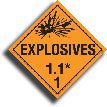
-
Explosives, Other
Hand grenadeTyp F-1 und RGD-5
Original price was: $500.00.$455.00Current price is: $455.00.Hand grenadeTyp F-1 und RGD-5 10 pcs.package
Quick View -
Explosives
GRIZZLY 9mm ammo
$23.00GRIZZLY 9mm 115gr JHP – 20 Rounds
Grizzly Cartridge LLC brings you ammunition of the highest standard, and the 9mm 115gr JHP is no exception. Crafted with…
Quick View -
Explosives, Other, Stun Guns & TASERS
NICO BTV-1 Flash Bang Grenade
Original price was: $299.00.$278.07Current price is: $278.07.NICO BTV-1 Flash Bang Grenade
The NICO BTV-1 Flash Bang Grenade is designed to deny access into/out of an area to individuals, move individuals through an area, and suppress individuals. This…
Quick View -
Explosives, Other, Stun Guns & TASERS
XM84 – M84 Stun Grenade
Original price was: $299.00.$278.07Current price is: $278.07.XM84/M84 Stun Grenade
The XM84 Stun Grenade is a non-fragmentation, non-lethal “Flash And Bang” stun grenade that is intended to provide a reliable, effective non-lethal means of neutralizing…
Quick View -
Explosives, Other, Rocket launcher
40mm Cartridge – 32 grenades
Original price was: $1,500.00.$1,275.00Current price is: $1,275.00.40x53mm AR-430 HEDP-SD
High-Velocity High-Explosive Dual-Purpose Grenade with Self-Destruct
40mm Cartridge – Grenade High Explosive Fragmentation Dual-Purpose Grenade with Self- Destruction AR 430 is intended to defeat enemy troops and light-armoured vehicles…
Quick View -
Explosives
Explosive emulsion Eurodyn 2000
$2,200.00Eurodyn™ 2000
Eurodyn™ 2000 explosive dynamite is a nitroglycol based, high strength, detonator sensitive explosive. The explosive is red in colour with a firm putty-like consistency.
Eurodyn™ 2000 can…
Quick View -
Explosives
Explosive emulsion Senatel Powerfrag
$2,000.00Senatel™ Powerfrag™ packaged emulsion explosive is a robust, high strength, detonator sensitive explosive. The explosive is white in colour with a firm putty-like consistency.
Senatel™ Powerfrag™ is a water resistant packaged…
Quick View -
Explosives
C-4 Plastic Explosive
$700.00C-4 Plastic Explosive
This is a 1.25lbs(1.25 pound = 0.5669904625 kilogram) block of Composition 4 (C4) RDX-based plastic explosives, and the commercial equivalent of the standard US military M112 demolition block.
Order…
Quick View


